| Botanical Name |
|
| Family |
Fabaceae - The legume and pod-bearing family. (Pea & Bean Family) |
| Pronunciation |
vir-GIL-ee-uh dy-vair-ih-KAY-tuh |
| Common Name(s) |
English: Pink Blossom Tree; Pink Keurboom; Keurboom
Afrikaans: Pienk Keurboom; Keurboom
|
| Plant Group |
- Tree A woody, self-supporting perennial plant usually with a single main stem and generally growing more than 6 meters tall.
|
| Plant Size |
- Small
| Tree | 4m to 8m |
| Shrub | 50cm to 75cm |
| Perennial/ground cover | 10cm to 20cm |
| Bulb | 20cm to 30cm |
| Succulent | 10cm to 20cm |
|
| Position |
- Partial Shade The area is in shade for part of the day and in full sun for part of the day.
- Sun The area is in full sun for all or most of the day, all year round.
|
| General Information |
- Drought Tolerance: Moderate The plant is moderately adapted to arid conditions and can survive short periods of drought and high temperatures without extra water.
- Evergreen Plants that have leaves all year round.
- Fragrant / Aromatic These plants posses a strong, usually pleasant odour.
- Frost: Half-hardy The plant is able to survive low temperatures and some frost but requires protection against severe frost.
- Water Loving Plants need a regular supply of water and must not be allowed to dry out for any length of time.
- Water Moderate These plants will need some extra watering compared to water-wise plants. Plant them together, in at least some shade and in a convenient proximity to the house so that grey water can be utilised during times of drought.
- Wind Tolerant Plants able to withstand the effect of strong winds.
|
| Specific Information |
If planted in an open space, Virgilia divaricata will form a rounded, low-branching crown. Virgilia is relatively short-lived (12 to 20 years), but is an excellent pioneer for the new garden, growing up to 1,3m per year. Within two or three years, it can provide shade in which slower trees can grow, disperse the wind or create a screen. While mature trees can survive a little frost, young trees must be protected for the first few years. The nectar rich flowers attract many insects and birds.
|
| Ad Break |
|
| Flowers |
| Description |
pea flower in sprays at the ends of branches
|
| Season |
- Spring to Summer Plants will seldom bloom for the entire season as given in the list, but should flower during a period within these parameters.
|
| Colour |
|
| Growth Rate |
- Very Fast Specifying growth rate can be very misleading as there is considerable variation of growth rate depending on type and species of plant, available water, supplementary feeding, mulching and general care, as well as the plants suitability and adaptability to the garden environment.
|
| Plant Uses |
- Attracts bees, butterflies or other insects This plant attracts insects which can be food for birds or other creatures in your garden.
- Attracts Birds This plant will attract birds.
- Boundary A plant useful for planting around the edges of the property to form a green or colourful backdrop, an impenetrable hedge, to hide walls or create privacy.
- Pioneer for new gardens A very fast growing plant, able to withstand hardship, that can be used to populate land that has recently been cleared of natural vegetation. These plants pave the way for slower-growing species by adding nutrients to the soil and creating leaf litter.
- Provides light / dappled shade A tree with an open to sparse canopy, through which varying degrees of sunlight can penetrate.
- Screen A tall hedge of suitable plants planted closely together and used as a windbreak, to block a bad view, to separate parts of the garden or as a backdrop.
- Suitable for smaller gardens Such plants do not have invasive root systems, remain small or controllable and can often be grown in containers.
- Wild Garden An indigenous garden planted for the benefit of wildlife and birds. Provides food, water, a variety of mini-biomes and no poisonous chemicals are used.
|
| Distribution and Habitat |
from the Klein Swartberg Mountains in the Western Cape to Van Staden's Pass near Port Elizabeth in Eastern Cape, in forest margins, usually near streams or rivers, and less often on hillsides and in thickets
|
| Planting Suggestions |
Plant young trees in full sun or semi-shade. They need good garden soil and plenty of water, especially during the first 2 to 6 years. These trees have strongly spreading surface roots and for optimum speed of growth, apply compost and organic mulch, regularly and generously.
The old method of digging a deep hole and filling it with soil and compost has resulted in many trees failing to thrive, dying, rotting at the base or worse still, falling over in later years due to poor root development. Refer to the following sites for the best method of planting trees:
Treehelp.com: Planting a tree
International Society of Arboriculture: New Tree Planting
Tree People: Plant the right way
For those of you who have a clay problem try:
Rod's Garden: Planting in clay soil
|
| Medicinal Uses |
|
| Ad Break |
|


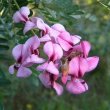


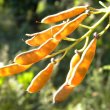
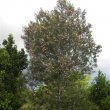

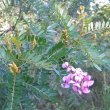
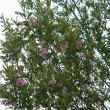
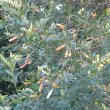


Comments
Cape Vagilia
We planted a Cape Vagilia last year and we are very happy with this tree. It has grown very fast and is attracting a lot of parrots to it. The parrots come to it several time a day and love eating something on the leaves. At first I thought they were eating the pods of the flowers but looked closer and realized that the flowers weren't coming out yet. It is now spring and the flowers are out and the tree look very pretty but the parrots are not attracted to eating the flowers, only something on the leaves. Could they be eating an insect on the leaves? Can anyone help with this query?
Parrot puzzle
Hi Norah
It would be interesting to know where you live as it seems unlikely to be in South Africa. Do let me know. There appear to be only three indigenous species of parrot found in South Africa. I looked up their diets but none of them has any form of insect included in their diets.
Some species of parrot do eat a small amount of insects but from your description of their behaviour, I don't think this is the case here.
I did discover that for many parrot species, both the new leaf shoots and young buds of plants make up quite a large part of their diet. This makes a lot of sense to me. The tiny, tender flower buds are hidden among the equally tender young leaves, and cannot yet be seen - by humans that is. The birds, however, see the young shoots as a succulent feast. The fact that they have not denuded the tree of flowers is testimony to the vast amount of flowers this tree produces.
Well, that's my theory. Perhaps someone will be able to clarify this.
Regards
Lorraine
Parrot puzzle
Hi Lorraine,
Thanks so much for replying to my query. I live in Sydney and have since found out that they are Rainbow Lorikeets that are eating the tree. I'm sure you're right about the young shoots being very appetizing to them and I'm very glad that we planted the tree because I look forward to the Lorikeets visiting us during the day and love watching them eating from it.
I have been growing the same tree in a large pot but will be planting in the ground, in the front garden, so that more birds can visit and feed from it.
Regards, Norah
Parrot puzzle resolved
Hi Norah
Thanks for the reply. I was pretty sure you were writing from Australia. And what lovely birds! I would so love to see a photo of them in the tree. If you do have any or get one in the future, please publish it/them.
If the specimen you have in the container has been potted for a long time, you may find that the roots have become pot-bound and curl around and over each other. This could result in the tree being smaller and may not anchor into the soil. In other words it may be permanently stunted. In a case like this I do try to separate and straighten the roots when I plant out but it this is not always successful.
Regards
Lorraine
Parrot puzzle
Hello Lorraine,
Thanks again for your useful information regarding my tree. I was surprised that your nursery is in South Africa because I thought you were in Australia. It has been lovely communicating with you and
I will send you a photo of the Lorikeets, as soon as they let me get close enough, because I don't have a zoom lense on my phone.
Kind regards,
Norah
Trimming Virgilia divaricata
Hi Lorraine
Can this species be pruned so it won't grow so high?
Kind regards
Niki Nicol
Virgilia divaricata - restricting height
Hi Niki
I have never tried this but I would think it can be done. Members of the Pea and Bean family invariably respond well to trimming and result in a denser, bushier plant. Do however be aware that once trimmed, the tree will send out strong leaders or shoots and these will also have to be cut back to keep the tree in shape.
Kind regards
Lorraine
pruning Virgilia divaricata
I live in Sydney....I made the mistake of doing this..not when it was small..(mine is about 3 y.o).I cut two fairly large branches off a couple of weeks ago.. and now it is totally dying... I now have to cut it down altogether... so No, they do not like to be trimmed.. that's my experience; such a shame as the rainbow lorikeets like to eat the nectar from the flowers... It will look terrible when it gets cut down,as it's such a pretty tree.. Regards, Christina.
Discuss this plant
Share knowledge, ask a question or give an experience.